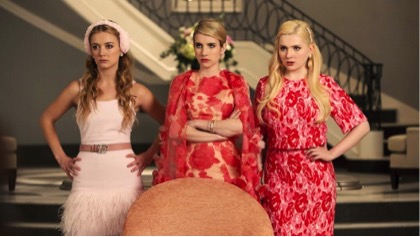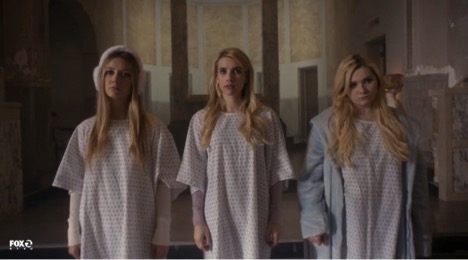Scream Queens: Season 1
Skip other details (including permanent urls, DOI, citation information)
: This work is licensed under a Creative Commons Attribution 3.0 License. Please contact [email protected] to use this work in a way not covered by the license.
For more information, read Michigan Publishing's access and usage policy.
The first season of Scream Queens presents viewers with biting commentary on horror clichés and millennial culture. Most notably, the series plays with the legacy of the 1980s slasher film and considers its resonance within a very different cultural context.
The slasher film has proven to be one of horror’s most iconic and instantaneously canonical subgenres. John Carpenter’s trend-starter Halloween premiered in 1978 and the first slasher parody, Student Bodies, debuted shortly after in 1981. It is an instantly identifiable pattern rich with stock types, plot conventions, and a comfortable association with camp. It is a formula in which the most normative gender tropes – the jock, the prom queen – suffer chaos wrought by an ambiguous “other.” In truth, it is conceivable to think of the slasher as something always and already queer. Writer/director Ryan Murphy’s comical take on the slasher formula aptly invokes this queer connotation while delving further into a millennial aesthetic of hyperbolic normativity. It is less a queer appropriation of the subgenre than an astute reconsideration that brings to the fore those qualities the slasher has traded in for decades.
Scream Queens opens in 1995 when a Kappa Kappa Tau sorority sister unexpectedly gives birth during a party. She is chastised by her fellow sisters for the mess, and left alone when the DJ plays TLC’s “Waterfalls.” “I am not missing ‘Waterfalls’,” one sister insists. “’Waterfalls’ is my jam!” Without sufficient medical care the sister bleeds to death, staining the house with a legacy of violence that haunts its latest pledges. In 2015, we are introduced to Grace (Skyler Samuels) and Zayday (Keke Palmer), smart and professionally ambitious women who join the house to revamp its image. We also meet the status quo of the house led by ultra-mean, chic, and elitist Chanel Oberlin (Emma Roberts), and her subordinates Chanel #3 (Billie Lourd) and Chanel #5 (Abigail Breslin). Grace and Zayday’s plan to change the house is aided by Dean Munsch (slasher veteran Jamie Lee Curtis), an avowed feminist who hates the sorority system and plans a Kappa sabotage by mandating that the sisters accept all interested pledges into the sorority.

In much the way non-normative roles seemed to individuate slasher protagonists of the 1980s – the “boyish” characteristics of Curtis in Halloween, the noted “sensitivity” of queer-coded male heroes in The Burning (1981) and A Nightmare on Elm Street 2: Freddy’s Revenge (1985) – a more intersectional “queering” of the sorority takes place throughout the show’s first season.
The world of Scream Queens is that of a preserved normative white utopia. Chanel Oberlin openly describes the Greek system as one of the only places left where you can continue to exclude undesirables without penalty. The looming threat to its existence is the move toward a community of inclusive compassion, even if only at the level of public relations. In the show’s pilot the emerging crisis of a campus killer is overshadowed only by the crisis of patently uncool sorority pledges, viciously labeled with nicknames emphasizing queer and non-normative qualities of sexuality and disability such as “Neck Brace,” “Deaf Taylor Swift,” and “Predatory Lez.”
The show represents millennial culture as one caught between a post-“Glee” move toward public compassionate acceptance and an otherwise acrid relationship to the self-importance reinforced by social media. A clear exploration of the internet’s role in self-affirming deprecation can be seen in Chanel’s celebration of “Chanel-o-ween.” This cold open segment from episode four, “Haunted House” directly parallels pop star Taylor Swift’s infamous “Swiftmas” video in which she “selflessly” (and publicly) sends hand-written notes and gifts to fans. Chanel likewise sends “Chanel-o-ween” presents to her Instagram followers in the form of severed heads, razor apples, etc. The aspects of privilege in Swift’s selfless performance are exaggerated here and further soured by the goriness of the deliveries that replace the cute tchotchkes given in Swift’s video.
Figure 2. Scream Queens takes on "Swiftmas" in "Chanel-o-ween"
Scream Queens’ finale, “The Final Girl(s),” plucks a noted phrase from Carol J. Clover’s Men, Women, and Chainsaws that characterizes the role of the slasher’s teen heroine, or “Final Girl,” as satisfying to the proverbial adolescent boy’s viewing fantasy. Her progress into self-assured aggression is a reference to the young male spectator’s tentative transition into “manhood.”[1] Yet Scream Queens picks its teeth with this analogy, harnessing a glossy and winking aesthetic groomed for the eyes of women and gay men.
“Neck Brace,” revealed to be named Hester (Lea Michele) is discovered as the main killer of the series in a twist during the finale. She and her brother had been the babies born to the mother who died during “Waterfalls.” In a flashback we learn Hester’s plan for revenge, which builds upon the knowledge that disability and other forms of stigmatizing identity make her socially invisible and benefit her subterfuge. She frames Chanel #’s 1, 3, and 5 for her crimes and stabs herself in the eye with a stiletto to avoid suspicion. Convicted for murder, Chanel rebuilds her mini-empire while locked inside a mental asylum. A final montage explores previously unconsidered facets of her emotional damage. One uncommonly sad moment reveals Chanel has returned to solid food in the absence of the normative social pressures that fueled her eating disorder – a running joke of the series.
Scream Queens relishes—and ultimately mourns—the glamorous cruelty of Chanel and her minions. It also nurtures an affectionate attachment to Hester whose plan of revenge satisfies more than it chills. In the quintessential 1980s slasher, rigidly normative teens often became the killer’s fodder while unconventional characters survived. With characters such as Chanel, Scream Queens makes the leap to a clearly satiric hyper-normativity. However, it is less ruthless and singular in its positioning of the audience with a non-normative protagonist. Ultimately the series posits something more complex about the social positions of its characters in relation to normativity and stigma. The title, “The Final Girl(s)” earns its tentative “(s)” in the dual survival of the non-normative Hester and the hyper-normative Chanel(s), both cruel in their own ways. They are, of course, wonderfully amusing, too.
Author Biography:
Peter Marra is a PhD candidate in Film & Media Studies at Wayne State University. His dissertation considers queer functions of the slasher film, its precedents, and permutations. He is the author of “Strange Pleasure: 1940s Proto-Slasher Cinema” in Recovering 1940s Horror Cinema: Traces of a Lost Decade (2015).



